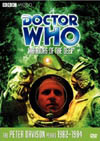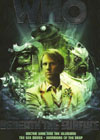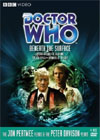DVD Extras include:
FIRST IMPRESSIONS"Warriors of the Deep" was the first Doctor Who novelization I found that featured a Doctor and companions that I knew I had seen on TV, in an adventure I had not yet seen on TV. I thoroughly enjoyed reading the tale in book form. It was full of interesting creatures, a backstory continuing from a mysterious prior era, and packed with action.The absence of "The Five Doctors" (the previous story) from TVOntario's schedules triggered a domino effect for a few years. Suddenly "Warriors of the Deep" was advertised as the upcoming finale of their run of Season 20, and having already read the book, I got excited believing that a great year was about to go out with the bang of a blockbuster. Episode One did not disappoint, largely since it allows the story's designers to show off most of the excellent things that work well in the story. Both undersea and outer space model work is quite impressive, while the human seabase interior design itself was full of impressive high-tech surprises. Though many fans criticize the high lighting levels in the base, such things never bothered me, and are in sharp contrast with the effectively dark and moody areas native to the Silurians and Sea Devils, which were particularly impressive. Add to that the fact that, as "The Five Doctors" had been skipped, the new advanced TARDIS console with working computers in it was new to me as well for this story. It seemed like much more money than usual was being put into this production, and I couldn't wait to see how good the rest would be..... Well, though episode two has a lot going for it at first, it soon all falls apart with a foam rubber door bending and rolling down to reveal the dreaded, fan-hated Myrka. Yeah, that wasn't so great. What always disappointed me even more was the lack of post-production for weapons effects. Where were the lasers I had imagined when reading the book? Knowing how much shoot-out action was coming up, I thought this was too lame for forgiveness. Even bullet guns should show a flash at the muzzle, but these were just a dull nothing. It all winds up looking too unfinished to be as exciting as anything from "Earthshock" (story no. 122), instead drawing attention to the fact that our actors are just acting. At least the sound effects for all this weapons fire were decent, suggesting an energy that the visuals couldn't match.
The Proof of the Story is in the Writing....Well, even if we were to apply some proper post-production to lift this adventure above many of the simple faults most fans complain about, there still remains the question of whether or not the story holds up well enough to justify itself. There is much to recommend it, and it does attempt to be truly noble with some of its ideas, but those ideas end up falling into a typical trap for this era of Doctor Who.While delivering a simple action story on one level, the story systematically sets itself up to tackle some bigger themes before it's done. But though the cast list is plentiful, we get precious little character on screen at any point. There's an early scene between Maddox and Karina that provides a nice bit, but we need much more of this type of scene and involving more of the other characters as well. Too many of the others are written quite blandly, lacking nuances, and all seem interchangeable with each other. These seabase personnel interact as believably as the crew of any of the Star Trek shows, or indeed the moonbase crew from "Space: 1999" which Johnny Byrne used to write and script edit for, but I think a few more character scenes would have been better use of screen time than all the numerous technical, transitional "Let's catch up with what's happening elsewhere" scenes. The plot also has great trouble integrating the Doctor and his companions at first. A few bits still work, but their biggest sequence of beats really doesn't. However, character introductions are all done much better here than they were in Byrne's previous tale "Arc of Infinity" (story no. 124). The TARDIS gets a proper materialization to start the story off right, and gets its due in introduction during this story as well. Eric Saward's tinkering with the script is also worth noting, since it begins to reshape the characterizations in dangerous ways. Turlough finally gets more to do in this tale than he has had since the Black Guardian trilogy, but he flips between the polar opposites of bravery and cowardice a few too many times and a bit too completely, probably indicating each time whether he was playing out an original Johnny Byrne passage or a Saward rewrite. Mark Strickson at least takes the opportunity to emote a little more than many of the other characters and breathe some much welcome life into many dialogue scenes. In the end though, Turlough somehow impresses as a less adult, more juvenile character here than elsewhere during his time on the show. It is probably the production-troubled action beats central to the main plot that work best from a writing point of view. Each side's goals are clearly defined, the barriers and challenges facing them are interesting, and opposing forces come together to engage in a conflict that audiences should theoretically find it easy to invest in. These are some story beats that many modern Who stories mysteriously miss - even after knowing how to set them up and resolve them later, the central conflict often fails to connect. Not here. "Warriors of the Deep" thankfully gets this part very right. The story's cliffhangers are nicely dramatic each time, although there is definite room for improvement.
"It is they who insist on fighting."The social commentary was a popular topic at the time. It seemed just about everyone except world leaders recognized the idiocy of each half of the world pointing deadly weapons at the other half, waiting for a shoe to drop to bring civilization as we know it to an end. Most of the critics of this situation failed to address the real reason that it had come into existence: there was way too much money to be made on interest payments by lending money to governments who were fearful and desperate to arm themselves quicker and more powerfully than their neighbour. Trying to point out the idiocy of retaliatory annihilation to the powers that be is in essence just arguing with their cover story - they never really believed in it either. Now that virtually no member of the public at large can be fooled into investing in it (and voting for it) any longer, they've moved on to new cover stories. "Warriors of the Deep" attempts to address this "cover story" as though it is the main issue. Without giving away anything more, I'll just say that I end up digging for the positive in a show that doesn't really present it. For further details, come back and read the in-depth analysis version of this review after you've seen the show.
Indeed, a lot of the character moments we get in this story
can be seen to place people on a
passive-aggressive arc. But in many ways, Saward also
gives this arc to the Doctor, with Peter Davison portraying
the early "passive" side of things.
Luckily, there is "another way". Most important is to learn to
generate something other than blame and criticism internally,
long before the question of whether to bottle it up passively
or let it out explosively ever comes up. This is where an
attitude of gratitude can pay huge dividends.
Learn to direct your mind, how to focus on thoughts
and philosophies and paradigms of your own choosing.
Find your "stillpoint".
Insist on the best from your own outlook on the world.
There is much more to be discussed concerning this story's ending
and the developing patterns under script editor Eric Saward,
but of course we'll save that for the
in-depth analysis version
of this review.
On the plus side, the Sea Devils' smart-looking battle uniforms
are a vast improvement over the ragged fishnet shawls we last saw them
wearing in
"The Sea Devils". The Silurians look a bit
different, without necessarily looking better. It is a bit of a shame
that there seems to be so little differentiation between them though.
A more deliberate attempt to make each one easily identifiable, as well
making Sauvix's higher rank amongst the Sea Devils more obvious,
would have been good. I think we can also be critical of the
hypnotically slow speed of just about all Silurian/Sea Devil movements.
They can be slow some of the time, but a bit more variety of speed,
particularly in making them appear more agile and urgent during battle,
would have been a worthy idea.
This story has become available on DVD and VHS video. Click on the Amazon symbol for the location nearest you for pricing and availability: Single Story versions:
Comments on this article are welcome. You may contact the author from this page:
|
|||||||||||||||||||||||||||||||||||||||||||










